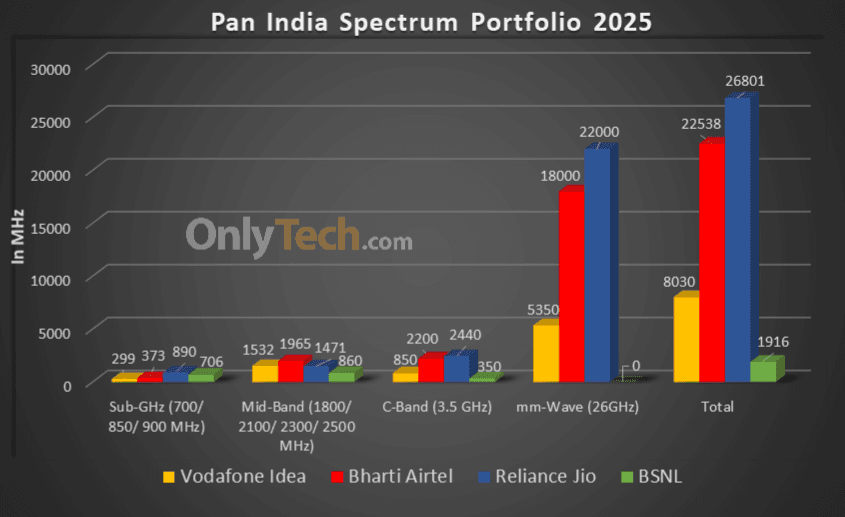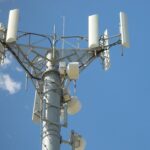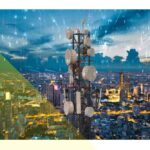Spectrum is for telecommunication what jet fuel is for aviation. Spectrum is a range of electromagnetic frequencies or airwaves that telecom companies use for establishing a connection between a cell tower and a mobile phone. The bandwidth of this spectrum is directly proportional to the speed of a wireless data network (since more data can be transmitted simultaneously through a broader data pipeline). In contrast, the frequency is inversely proportional to the coverage (since lower frequencies penetrate better through physical barriers and thus have wider coverage).
The spectrum holding data sheet embedded in this article represents the current spectrum holdings of all active telecom operators across all frequency bands across all 22 telecom circles along with their liberalisation status and expiry dates. All figures represented are in MHz. The value mentioned in the bracket beside the frequency at the base of each sheet is the band number where ‘B’ stands for 4G LTE band whereas ‘n’ stands for the corresponding 5G NR band.
The spectrum shown under BSNL and Aircel in white is reserved for the respective operators but has not yet been officially allotted to them.
Spectrum Liberalisation:
Spectrum was administratively allocated to operators in each of the 22 licensed service areas or circles prior to 2010, this spectrum is called non-liberalised and can only be used for 2G services whereas all airwaves allotted post-2010 have been through a Spectrum Auction where operators have paid the market discovered price and this spectrum is called liberalised and can be used for any technology platform 2G/3G/4G/5G. Alternatively, operators may choose to liberalise their administratively allotted spectrum by paying the market-discovered price to DoT on a pro-rata basis for the remaining validity of the spectrum.
Paired and Unpaired spectrum:
Spectrum may be paired or unpaired, bands 1/3/5/8/28 are all paired where one set of frequencies is used for uplink whereas another distinct set of frequencies is used for downlink known as Frequency-division duplexing (FDD), whereas bands 40/41/78/258 are unpaired where both uplink and downlink happens in the same set of frequencies separated by the time of uplink and downlink known as Time-division duplexing (TDD).
List of Indian FDD Bands:
| 4G LTE band | 5G NR band | Uplink frequency range (MHz) | Downlink frequency range (MHz) | Bandwidth for telecom (MHz) | Block size (MHz) |
|---|---|---|---|---|---|
| B1 | n1 | 1939-1979 | 2129-2169 | 40×2 | 5×2 |
| B3 | n3 | 1710-1780 | 1805-1875 | 70×2 | 0.2×2 |
| B5 | n5 | 824-844 | 869-889 | 20×2 | 1.25×2 |
| B8 | n8 | 890-915 | 935-960 | 25×2 | 0.2×2 |
| B28 | n28 | 723-733/ 738-748 | 778-788/ 793-803 | 20×2 | 5×2 |
List of Indian TDD Bands:
| 4G LTE band | 5G NR band | Frequency range (MHz) | Bandwidth for telecom (MHz) | Block size (MHz) |
|---|---|---|---|---|
| B40 | n40 | 2300-2380 | 80 | 10 |
| B41 | n41 | 2535-2555/ 2615-2655 | 60 | 10 |
| – | n78 | 3300-3670 | 370 | 10 |
| – | n258 | 24250-27500 | 3250 | 50 |
Spectrum caps:
A spectrum cap dictates how much spectrum a particular operator can hold in a circle for a specific band. There is a 40% cap for Sub-GHz spectrum in the 700/850/900 MHz bands combined, a 40% cap for Mid-Band spectrum in the 1800/2100/2300/2500 MHz bands combined, a 40% cap for the C-Band spectrum of 3300-3670 MHz and a 40% cap for the mm-Wave spectrum bands of 24.25-27.5 GHz. The current spectrum caps are denoted in the spectrum chart.
Overall spectrum holdings of operators (in MHz):
| Operator/Holding | Jio | Airtel | Vi | BSNL |
|---|---|---|---|---|
| Sub-GHz | 890 | 373.2 | 298.8 | 706 |
| Mid Band | 1470.8 | 1964.9 | 1531.6 | 860 |
| C-Band | 2440 | 2200 | 850 | 350 |
| mm-Wave Band | 22000 | 18000 | 5350 | 0 |
| Total | 26,800.8 | 22,538.1 | 8,030.4 | 1,916 |
Spectrum sharing/trading/leasing guidelines:
- Telecom operators holding CMTS/UASL/UL licenses can enter into a Spectrum-Sharing agreement with each other so long as both parties hold liberalised spectrum in the same band in the same circle. Spectrum sharing is possible only on a Pan LSA level in block sizes defined by DoT and only after one year of an operator acquiring the spectrum.
- Telecom operators holding CMTS/UASL/UL licenses can enter into a Spectrum-Trading agreement with each other so long as the spectrum being sold is liberalised. Trading of spectrum is possible only on a Pan LSA level in block sizes defined by DoT and only after two years of an operator acquiring the spectrum.
- Telecom operators may enter into a Spectrum-Leasing agreement only with Enterprises holding a Captive Non-Public Network (CNPN) license and not with each other. The lease may be limited to any geographic area within the LSA and for any duration mutually agreed upon by both parties. A CNPN licensee can lease spectrum from multiple operators within an LSA.
Note: We update this chart in real-time to ensure it is always up to date with the latest changes in spectrum holding. Certain human errors might have crept in during the manual compilation of the data, any mistakes/ rectification can be brought to the Team’s notice through the comments section below.








Hi Esmail,
One off-topic question, Should I purchase iPhone 11 at 50K or wait for 12, I am just worried about the lack of 5G support in iPhone 11.
Thanks
Considering that the launch of iPhone 12 is just next week it wouldn’t be a wise decision to buy iPhone 11 now. The 5G capability is a must have at this point considered that we might have 5G launch in India as early as next year, soon after the auction and if you are spending 50k you might as well add some more and get a future ready phone.
I’m actually planning to buy the Zenfone 7 by March to June, so I’m hoping Jio makes band 78 the default band in all the small cells, and doesn’t grab mmWave just yet. Zenfone 7 has a bunch of 5G bands enabled, but it’s not released in India yet, and I guess they’ll release it here in December or Jan.
I read that some high level fellow said that b78 has very little spectrum, so hopefully they will double the amount of spectrum available so that Jio gets at least 100MHz block in that band alone. But they keep delaying the frigging auctions… Every. Damn. Time… SMFH
Yes, out of the total 300 MHz from 3300-3600 MHz, 100 MHz from 3300-3400 MHz is reserved for the Ministry of Defence (MoD), 25 MHz from 3400-3425 MHz is reserved for Department of Space (DoS) and 175 MHz is with Department of Telecom (DoT) which is available for 5G in n78 (B42).
There is a lot of confusion regarding the mm-wave spectrum. Department of space does not want to free up 26GHz spectrum range. Govt is yet to decide on an auction of mm-wave spectrum
Apart from n78, I think phones should also have 700MHz support for 5G. There is a huge chunk of spectrum available, and it won’t have coverage issue also. If Jio is willing to launch 5G in next year itself, then it will be probably on n28 as govt is in no mood to auction the high-frequency spectrum in next auction.
It’s unlikely Jio will want to use 700 MHz as n28 for 5G it may rather use it as B28 to augment it’s LTE coverage in the sub GHz band. The amount of spectrum available in band 28 is insufficient for 5G services, Jio will want to go for a 100 MHz chunk in n78 for 5G.
Got it, I thought that currently, Jio has good coverage by having band 5. It can get 15MHZ in almost all circle. So thought that it would make use of band 28 for 5G.
Also UK is going to use 700MHz for 5G, Is less spectrum available in this band just in India?
The band has a capacity of 45 MHz paired spectrum, of which 10 MHz is reserved for the defence forces, 5 MHz for the railways and 30 MHz is available for commercial Telecom. Even if Jio picks up a good 20 MHz it will only be sufficient for LTE speeds, not really the gigabit speeds that 5G is capable of.
Jio would want to have a blanket coverage for its 4G network even in rural areas with less tower density while the 5G use cases will be more profound in densely populated urban areas with high tower density where it would want to use the high frequency bands to add to capacity.
Wonderful work Esmail. I have one doubt.
Can a teleom operator keep increasing the number of towers to increase the demand, given that each tower is operating at its maximum bandwidth, and should not cross spectrum limit in a certain area, specifically in metros?
Thanks Venkat. Yes increasing the number of towers is an interim solution to meet the increasing data demand in a situation where the spectrum held is insufficient. But there is a limit to which this can help, Jio in its recent letter to the government said clearly that they have reached an infliction point where they can’t add more towers and urgently need to buy more spectrum. As for the towers operating in a certain bandwidth, they can only operate using the frequency range that the operator owns the rights to.